UFC 290 Aftermath: How Volkanovski Used Wrestling and Footwork to Defeat Rodriguez
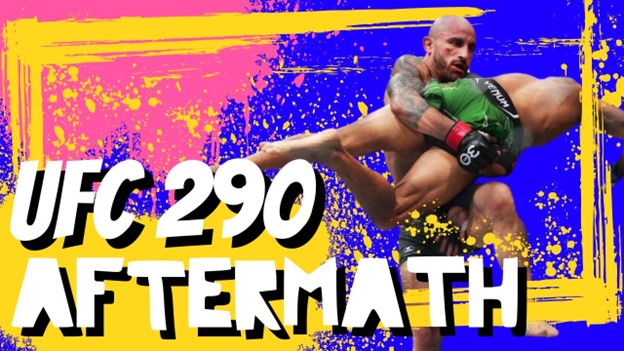
Blaine Henry/Sherdog.com illustration
UFC 290 was all that and a bag of chips. From the way Robbie Lawler called it a career to the crowning of a new flyweight king, the card was worth every cent. Atop that bill was the domination of Yair Rodriguez by Alexander Volkanovski to unify the featherweight title. Today we will look at that bout and how Volkanovski brought new things to his game that we don’t traditionally see in his fights. It’s time for Aftermath!
Advertisement
“D1 Volkanovski”: A Wrestling-Heavy Approach
Many did not give Rodriguez much of a chance against Volkanovski, but readers of Beforemath will know that this was the type of fight that could be dangerous for Volkanovski and Rodriguez had a decent chance of winning. Volkanovski thought so too, saying in his post-fight speech that there was actually fear in him about Rodriguez and his striking. This, he said, led him to train harder for this fight. That’s high marks from someone who stared down the Dagestani Dynasty.
Part of me worried that Volkanovski would try and bang with Rodriguez and get his head kicked in, but Volkanovski did not take the Jon Jones approach and went out to avoid that striking. We often talk about taking away your opponent’s best weapon: If mobility is their strong point, smash the legs. Are they a cardio machine? Smash the body. Big, looping overhand right? Straight punch. Taking away your opponent’s best weapon forces them to rely on their second-best weapon and often, even top contenders’ second-best weapon is mediocre.
At the heart of it all, Rodriguez’ best weapon is his striking,
especially against a shorter, slower and older Volkanovski. So, to
take away striking as a whole from Rodriguez, Volkanovski took the
fight to the mat, where Frankie
Edgar and Max
Holloway had had success. Success there from Volkanovski was
critical as well. After about a minute and a half of feeling out
from both fighters, Volkanovski managed to take Rodriguez down,
where he could start to wear on his opponent’s cardio. Part of the
path to success laid out in Beforemath was the fact that catching
the kicks of Rodriguez would be a way to get the fight to the
ground early.
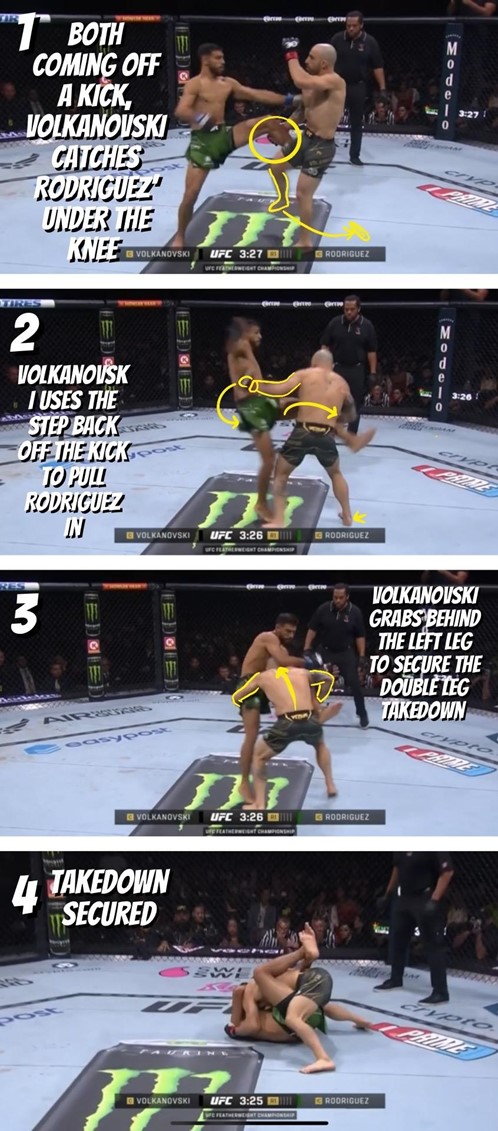
Blaine Henry/Sherdog.com illustration
As Volkanovski and Rodriguez kicked at the same time, Volkanovski was able to catch the body kick of Rodriguez and (1) snag the knee. Volkanovski threw the low outside kick from southpaw and after catching the kick, (2) he would step back into orthodox pulling Rodriguez towards him. As he corralled the leg under his arm, (3) Volkanovski grabbed behind the right thigh of Rodriguez to lock in a double leg takedown and (4) slam Rodriguez to the mat.
From this position, Volkanovski pushed Rodriguez to the fence and pushed his head against the cage. While the wall-walk was a threat there, submissions are that much harder. Rodriguez likes to throw up wild armbars and triangles to force action from a fighter. If he can lock in a submission, great. If not, he keeps the opponent off of him. By pressing him against the fence, Volkanovski decided to give up the wall walk in lieu of that, betting on his mat return skills to get the fight back down. This paid off as Volkanovski managed to do this a few times, allowing him to rack up seven takedowns on 12 attempts.
This wrestling onslaught allowed Volkanovski to not only take away Rodriguez’ best weapons by putting him on his back, but also slowed him down on the feet to a more manageable speed. This all played into the third round which saw Volkanovski put the fight away.
New City Kickboxing Tricks: A Bit Old, A Bit New
The entire premise of Beforemath was about Alexander Volkanovski being plugged into the City Kickboxing system and how that plethora of knowledge would give him opportunities to show us something new. A lot of what he did at UFC 290 was new and some of it was what we’ve come to know Volkanovski for.
While the wrestling was the no. 1 factor for Volkanovski and his victory over Rodriguez, it was the hands that finally got him the stoppage in the third round. While Rodriguez is the one typically known to switch stances and give his opponent trouble with his footwork, it was Volkanovski that really went out there and gave Rodriguez trouble with the footwork and the hands in round three. While we didn’t get any hand fighting traps like we discussed in Beforemath, we got some classic Volkanovski instead.
The third round really showed Volkanovski’s best work on the feet at UFC 290. While he did get tagged while he was insistent on striking, he did managed to feel out Rodriguez and slow him down with all the wrestling. Early in the third round, we see Volkanovski to start to piece things together and start to land the effective blows. To do this, he relied on the ability to switch hit and land from both southpaw and orthodox, which is where we will be spending the rest of this article.
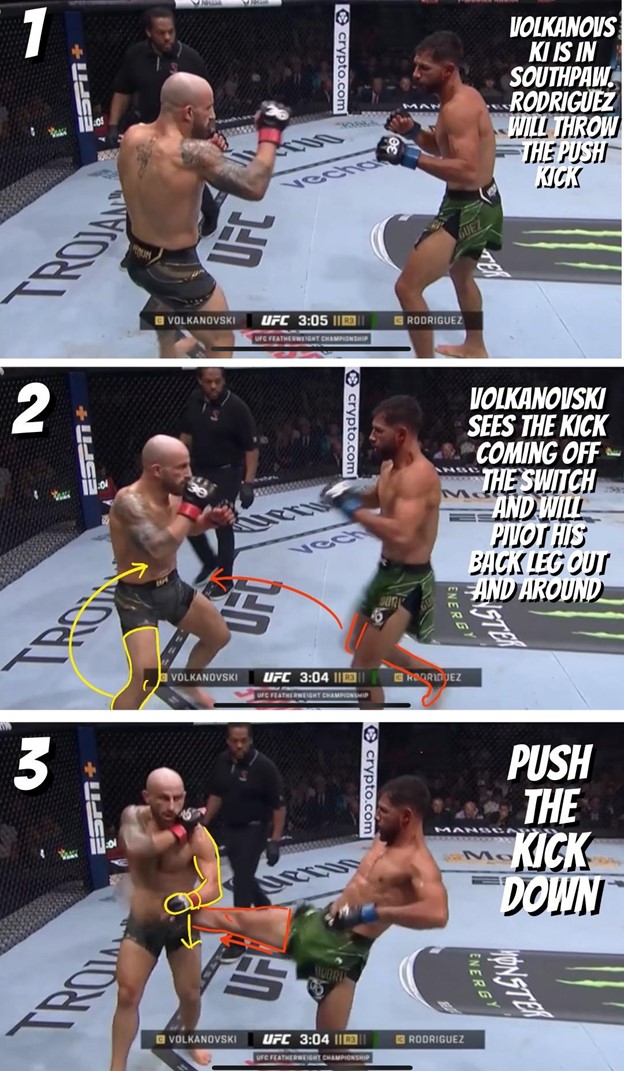
Blaine Henry/Sherdog.com illustration
Rodriguez loves to throw a push kick as he’s coming forward. It’s something he always goes to and did constantly against Volkanovski. (1) As Volkanovski decided that it was time to blade the stances again, he would want to switch to orthodox to match Rodriguez. As he did this, (2) Rodriguez would use the time it takes to switch as a chance to throw that push kick. But Volkanovski would read the kick and (3) pivot his new rear leg, the right leg, out and around the kick. The result is Rodriguez’ push kick going through where Volkanovski was, not where he currently is. For good measure, Volkanovski would push the kick down to make sure Rodriguez wasn’t up to any funny business.
From here, Volkanovski did have options to punish Rodriguez. Notably, a step-up knee now that he’s outside of the leg of Rodriguez would have been massive. Pounding the midsection so heavily is always a boon to a fight plan. He also has the right hook now that he’s angled off to the side and this would be the approach Volkanovski would go with.
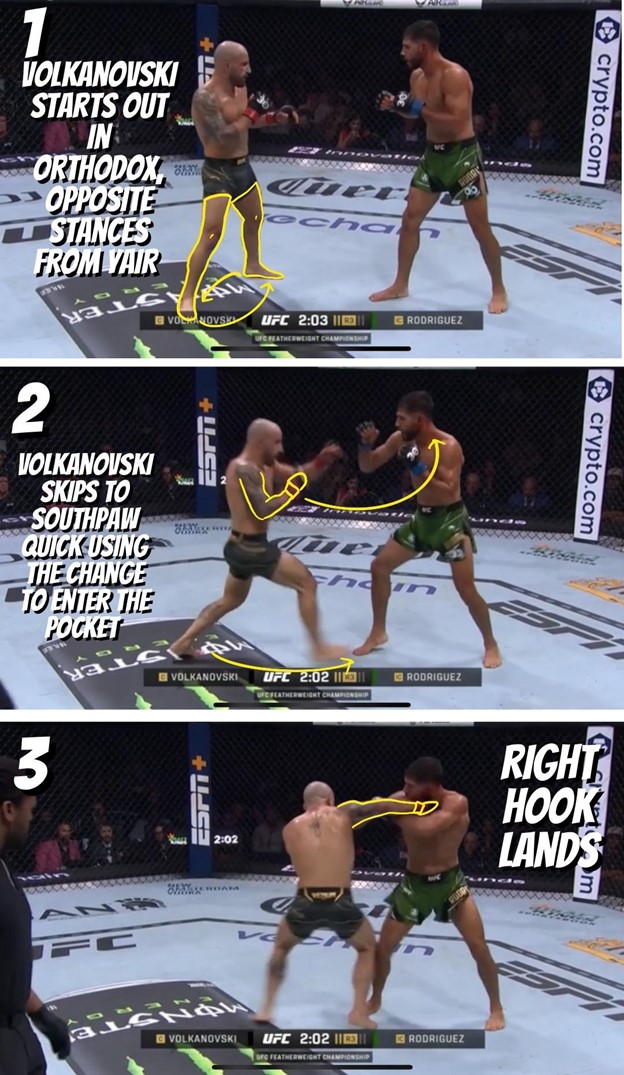
Blaine Henry/Sherdog.com illustration
Around the midpoint of Round 3, Volkanovski started getting the better of the exchanges with Rodriguez. Above we see how Volkanovski did so despite being shorter and slower than Rodriguez. (1) Starting out in a mirrored stance (Volkanovski in orthodox, Rodriguez in southpaw) Volkanovski will want to be in a bladed stance and match what Rodriguez did. He switched with Rodriguez all night and here, he would use the stance switch as his attack. (2) Volkanovski would switch quickly and hop forward on his switch to southpaw. The switch was so fast and Volkanovski attacked so quickly off of it that Rodriguez didn’t have the chance to mentally switch to defense from a southpaw. This means his left hand is a little lower than it should be and (3) Volkanovski hammers a right hook home, the same punch we will be looking at later on.
In a stance switching matchup, the greatest advantage is in the set of attacks presented by both southpaw and orthodox. In this case, with the two mirroring each other, Rodriguez is in the mindset that the cross will come from the right side of Volkanovski. He can, in theory, keep his right hand a little lower and loaded for his own cross as he will have a little bit of time for the punch from Volkanovski to travel. The sudden switch to southpaw allows the right hook of Volkanovski to be quicker and this finds the mark. Volkanovski uses this a lot. He will lure fighters in and out of range simply by stepping back into the opposite stance from what he’s in.
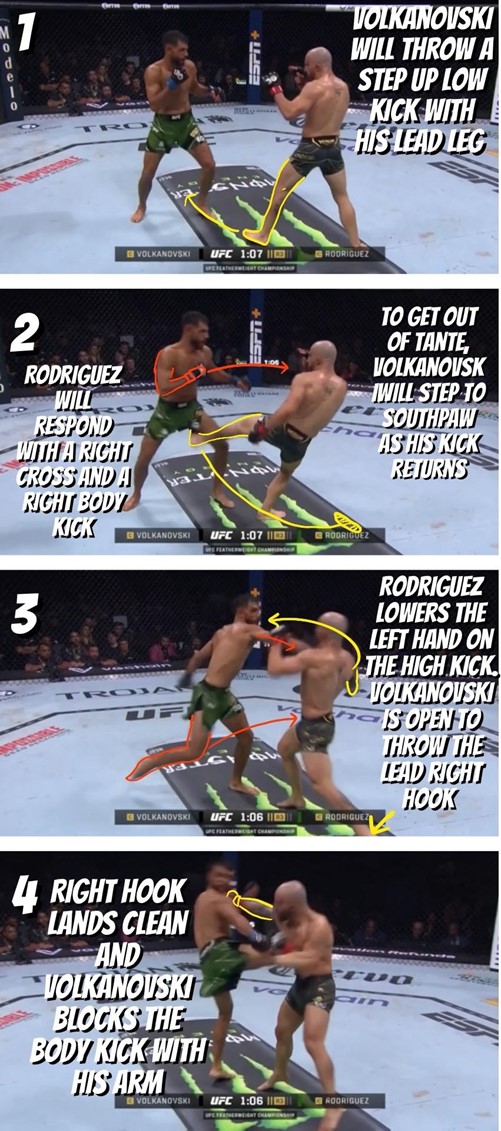
Blaine Henry/Sherdog.com illustration
Next, we look at the sequence that ended things for Rodriguez. In orthodox, (1) Volkanovski would step up and throw the lead low kick. Rodriguez would see the low kick and would want to (2) counter with what should be a proper counter: a right cross. He would then follow up with a right kick across the body to take some of the steam out of Volkanovski’s sails, or so he thought. Knowing what we know about how Volkanovski switches stances and steps back to change the range, (3) it’s no surprise to see just that here and Volkanovski steps back with that kicking leg into southpaw. Much like the last right hook we looked at, Volkanovski set up the opening with the stance switch. Instead of it being because of the speed, it was the timing that opened up the right hook. Instead, notice that on the body kick that Rodriguez is forced to lower his hand, a standard practice to keep balance. (4) Volkanovski would land the right hook clean and block the body kick with his forearm.
This sequence buzzed Rodriguez and forced him to back up against the fence. After unloading on Rodriguez, Volkanovski would lock up with Rodriguez and dump him to the floor, taking away his weapons completely, and pounding him out for the win.
The win for Volkanovski added to his already great legacy. After losing the fight to Islam Makhachev and still improving his legacy there, I questioned if he would be able to come with the same vigor that he has in the past. While he is 34 years old, pretty old for a featherweight, Volkanovski looked phenomenal. Should he fight Makhachev or Ilia Topuria next doesn’t matter. Either fight adds a lot to his resume and will be a treat for his fans.
« Previous Fight Facts: UFC 290 ‘Volkanovski vs. Rodriguez’
Next Stipe Miocic Plans to ‘Show People I Deserve to Be Heavyweight Champ’ at UFC 295 »
More




 UFC News & Features
UFC News & Features

